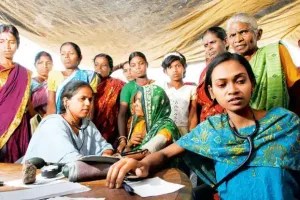Teen Pregnancies Drop In India, Urban Rural Divide Still High

Teen pregnancies declined in most states and UTs of the country but there continues to be a great divide between rural and urban India according to the latest data of the The National Family Health Survey (NFHS)- 5 released by the Ministry of Health and Family Welfare in December 2020. 16 of 22 states for which data has been released thus far saw a decline in teen pregnancies from the previous round of NFHS-4 released in 2017, where 8 % of Indian women aged between 15-19 had begun childbearing.
One-fifth of all the global adolescents live in India, according to a study published in The Lancet. Teenage childbearing, is known to be the biggest factor affecting adolescent health and well-being. 95% percent of all adolescent child births occur in low-income and middle-income countries.
At Behanbox, we analyse data on teenage pregnancies, to show the changes in teenage childbearing over years and make comparisons across several regions in India. While the NFHS-5 phase-I data does not provide information about the caste, class, religion specific composition of teen pregnancies in India, we use NFHS-4 data to understand teen pregnancies in different demographics. The National Family Health Survey defines teenage childbearing as women aged 15-19 who have had a live birth or are pregnant with their first child at the time of the conduct of the Survey.
Decline in Teenage Childbearing
Fewer women in teenage years are bearing children in most states in India. Three-fourths of the states saw a drop in teen pregnancies from NFHS-4. Teenage girls having children has halved in Telangana, which saw the largest drop between the two surveys. Karnataka, Gujarat, Bihar, West Bengal and Mahashtra also saw a decline.
The north-eastern states show a variation in trends. The percentage of pregnant teenage women declined from 7.2% in 2017 to 4.1 % today. While Nagaland and Meghalaya also saw a significant decrease, Tripura saw an increase from 19 % to 22 % in the period between the two surveys.
Himachal Pradesh and Andhra Pradesh, saw a marginal increase in percentage of childbearing women in teen years. Kerala, Goa and Sikkim did not witness any change.
Studies show that children born to teen mothers are at a higher risk of being undernourished. Adolescent mothers experience severe health consequences. Adolescents aged below 16 years face four times the risk of maternal death, compared to women in their twenties. WHO indicates that low- and middle-income countries account for 99 % of the maternal deaths of women aged between 15 and 49, worldwide. Studies also indicate that teenage mothers are more likely to experience marital violence and school drop-outs which further jeopardize the child’s health and educational opportunities, leading to a cycle of poverty and undernourishment.
Higher Teen Pregnancies In Rural Areas
Every one out of four Tripura’s rural women aged 15-19 have borne children. 14.4 % of adolescent urban women in Tripura have experienced or are experiencing pregnancy. There is a gaping divide between teen pregnancies in rural and urban areas across India, exceptions being Goa and Himachal Pradesh. The urban rural gap continues from the last round of NFHS in 2017 where rural teen pregnancies were twice as much as the urban ones.
In West Bengal, the percentage of teen mothers in rural areas is more than double their urban counterparts. In Maharashtra, the percentage of teen pregnancies in rural areas is almost three times the urban areas.
In contrast, urban Himachal Pradesh has more teen mothers.
Although marriage of women below the age of 18 years is illegal in India under the Prohibition of Child Marriage Act, 2006, many young women in rural areas continue to be married off early. In several such scenarios, teenage pregnancies are a result of the pressure to consummate the marriage and low sexual and reproductive education.
Higher Teen Pregnancies Among Adivasi Women
Teenage pregnancies also vary by caste and class and have a bearing on the likelihood of early childbearing. While the NFHS-5 is yet to release data about the caste, class, religion and schooling factors, NFHS-4 conducted in 2017 gives crucial insights.
10.5% of teenage mothers were Adivasi women, followed by Scheduled caste women (8.8 %) and 7 % of OBC women.
The percentage of teen pregnancies in 2017, significantly reduced as incomes increase in households. Women in lowest economic classes were four times more likely to be teen mothers than the highest ones.
More than half of the women between 15-19 who were married at the time of the NFHS (2017) were pregnant or given birth. One-third of separated and deserted women in the age group were mothers. It is important to note that the NFHS does not account for any unmarried teen pregnancies.
Childbearing among young women is strongly associated with lower educational levels of the childbearers. The NFHS-4 indicates that the percentage of teenage mothers decreased with increasing levels of schooling. While every one in five women aged 15-19 with no schooling had begun childbearing, only 4 % of the adolescent women with 12 or more years of education were teen mothers.
Teen pregnancies were highest among Muslims where 9 % of teenage women were mothers and lowest among Jains.
The Indian Penal Code continues to criminalise abortion in India. The Medical Termnination of Pregnancy (Amendment) Bill, 2020 was passed by the Lok Sabha in March 2020 to amend the Medical Termination of Pregnancy Act, 1971, which among other provisions, law does not allow pregnant persons under the age of 18 to consent to abortion, without the consent of a parent or a guardian. The bill also jeopardizes the privacy of the person wanting to terminate pregnancy, by allowing information access to “persons authorised under law”. Moreover, the bill does not extend the rights to trans, intersex and non-binary pregnant persons.
We believe everyone deserves equal access to accurate news. Support from our readers enables us to keep our journalism open and free for everyone, all over the world.



